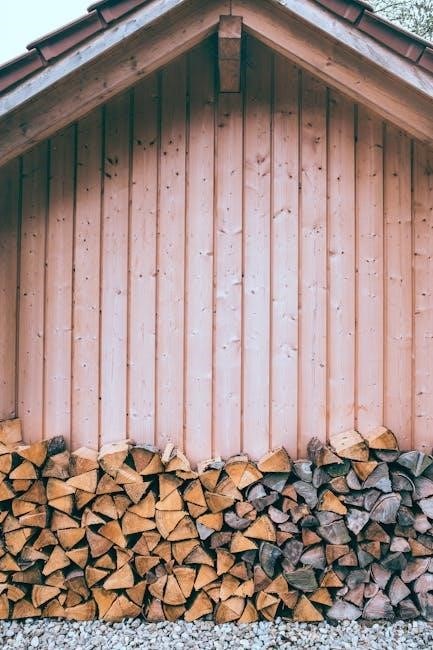This guide provides essential resources for building safe and durable residential wood decks‚ focusing on design‚ materials‚ and construction methods compliant with the International Residential Code (IRC).
It addresses load calculations‚ lumber selection‚ permits‚ and safety inspections‚ ensuring decks meet structural integrity and safety standards for long-lasting outdoor structures.
Importance of Following Deck Construction Guidelines
Adhering to deck construction guidelines ensures safety‚ structural integrity‚ and compliance with local building codes. Properly designed decks prevent collapses and injuries‚ safeguarding occupants and property. Guidelines outline materials‚ load calculations‚ and best practices‚ ensuring durability and resistance to environmental factors like rot and decay. Non-compliance can lead to legal issues‚ fines‚ and increased liability. Following prescriptive methods guarantees decks meet minimum safety standards set by the International Residential Code (IRC). This approach minimizes risks and ensures long-term performance‚ providing peace of mind for homeowners and contractors alike. Compliance also enhances the aesthetic and functional value of outdoor living spaces.
Purpose of the Prescriptive Residential Wood Deck Construction Guide
The purpose of this guide is to provide clear‚ straightforward instructions for constructing safe and durable residential wood decks; It outlines prescriptive methods that meet or exceed the International Residential Code (IRC) requirements‚ ensuring compliance with local building standards. The guide addresses key aspects such as materials‚ design‚ and construction practices‚ offering practical solutions for common challenges. It serves as a comprehensive resource for homeowners‚ contractors‚ and inspectors‚ promoting consistency and safety in deck building. By following the guide‚ stakeholders can ensure that decks are structurally sound‚ aesthetically pleasing‚ and long-lasting‚ while also meeting regulatory expectations.

Regulations and Codes Governing Deck Construction
Deck construction must comply with local building codes‚ primarily the International Residential Code (IRC)‚ to ensure safety‚ durability‚ and structural integrity. Permits and inspections are required.
Overview of the International Residential Code (IRC)
The International Residential Code (IRC) provides comprehensive standards for residential construction‚ including wood decks‚ ensuring safety and durability. It covers structural requirements‚ material specifications‚ and design loads. The IRC mandates minimum standards for deck components like footings‚ beams‚ and railings‚ addressing both prescriptive and engineered approaches. Compliance with the IRC is enforced through permits and inspections‚ ensuring adherence to local building regulations. By following IRC guidelines‚ builders can construct decks that meet safety and performance expectations‚ reducing risks and enhancing user safety. Proper understanding of the IRC is essential for successful deck construction projects.
Permits and Approvals Required for Deck Construction
Obtaining the necessary permits and approvals is a critical step in deck construction to ensure compliance with local building codes and safety standards. The International Residential Code (IRC) mandates that all deck construction projects adhere to specific guidelines‚ which typically require a building permit. Before commencing construction‚ detailed plans must be submitted for review and approval by local authorities. These plans should include structural details‚ materials‚ and dimensions to ensure they meet IRC standards. Regular inspections during and after construction are conducted to verify compliance with the approved plans and safety regulations. Failure to obtain the required permits can result in legal penalties and potential safety hazards. Therefore‚ it is essential to work closely with local building departments throughout the deck construction process to ensure all requirements are met.
Materials and Lumber Selection for Deck Building
Choose durable‚ pressure-treated‚ or naturally resistant lumber like redwood or cedar. Ensure materials meet IRC standards for structural integrity and safety in outdoor environments.
Recommended Types of Lumber for Deck Construction
For deck construction‚ No. 2 Grade lumber or higher is recommended to ensure durability and strength. Pressure-treated wood is ideal for resisting rot and termite damage‚ while naturally durable species like redwood and western cedar offer inherent resistance. These materials are suitable for various deck components‚ including beams‚ joists‚ and decking boards‚ ensuring compliance with IRC standards. Proper lumber selection is critical for structural integrity and safety‚ making it a cornerstone of successful deck building projects.
Fastening Requirements for Wood Decks
Fasteners play a critical role in ensuring the structural integrity of wood decks. The IRC specifies that galvanized or stainless steel fasteners‚ such as nails‚ screws‚ or bolts‚ must be used to resist corrosion. Spiral or ring-shank nails are recommended for their superior holding power in treated wood. Wood screws must meet ANSI/ASME B18.6.1 standards‚ while bolts and lag screws must comply with ANSI/ASME B18.2.1. Proper spacing and placement are essential to handle load requirements‚ with joists typically spaced 16 inches on-center. Through-bolting is recommended for beam-to-post connections to ensure maximum strength and stability‚ adhering to IRC guidelines for safe and durable deck construction.

Design Considerations for Residential Wood Decks
Designing a deck involves calculating load-bearing capacity‚ ensuring proper beam spans‚ and spacing joists to meet IRC standards for safety and structural integrity.
Load Calculations for Deck Design
Load calculations are critical for ensuring a deck’s structural integrity. The International Residential Code (IRC) specifies a live load of 40 pounds per square foot (psf) and a dead load of 10 psf for residential decks. These calculations determine the weight a deck must support‚ including people‚ furniture‚ and other elements. Proper load distribution ensures beams‚ joists‚ and footings are adequately sized. Factors such as beam spans‚ joist spacing‚ and post placement must align with calculated loads to prevent structural failure. Accurate load calculations are essential for compliance with building codes and ensuring the safety and durability of the deck.

Beam and Joist Span Requirements
Beam and joist spans are critical for ensuring structural stability in deck construction. According to the IRC‚ beam spans must align with Table 3‚ allowing extensions beyond posts up to LB/4. Joists attached at the house and to the side of the beam have specific span limits‚ as outlined in Figures 1B and 2. These requirements ensure proper load distribution and prevent structural failure. The type of lumber and load-bearing capacity significantly influence span lengths‚ making accurate calculations essential. Adhering to these guidelines ensures compliance with safety standards and guarantees a durable‚ structurally sound deck design.
Construction Guidelines for Safe and Durable Decks
Proper site preparation‚ footing installation‚ and framing techniques are essential for building safe and durable decks. Follow IRC guidelines for structural integrity and thorough inspections.
Site Preparation and Footing Requirements
Proper site preparation is crucial for a stable and durable deck. Begin by leveling the ground and removing debris to ensure a smooth construction process. Accurate load calculations‚ including live load (40 PSF) and dead load (10 PSF)‚ are essential for determining footing sizes. Footings must extend below the frost line to prevent shifting due to freezing temperatures. Use pressure-treated or naturally durable wood for footings to resist rot and decay. Ensure all materials meet IRC standards and local building codes. Properly spaced and sized footings are vital for distributing weight evenly and preventing structural failure. Compliance with IRC Section R507 for wood-framed decks is mandatory for safety and longevity.
Framing and Assembly Best Practices
Proper framing and assembly are critical for a structurally sound deck. Ensure beams are sized and assembled according to IRC tables‚ with spans not exceeding recommended limits. Joists must be securely attached to beams and ledgers‚ using approved fasteners like 1/2 diameter bolts or lag screws. Ledger boards should be tightly fastened to the house frame to prevent detachment. Decking boards should be spaced with 1/8 inch gaps for water drainage. Use No. 2 Grade lumber or higher‚ and ensure all lumber is pressure-treated or naturally durable to resist rot. Properly align and secure all framing components to distribute loads evenly and prevent structural failure. Always follow IRC guidelines for beam and joist spans to ensure safety and durability.

Safety Inspections and Maintenance
Regular inspections and maintenance ensure deck longevity and safety. Check for rot‚ damage‚ or loose fasteners‚ addressing issues promptly. Clean debris and inspect railings‚ stairs‚ and supports annually.
Post-Construction Inspection Checklist
A thorough post-construction inspection ensures all components meet safety and structural standards. Check the following:
- Verify footings are properly set and secured to the deck frame.
- Inspect beams and joists for proper sizing‚ spacing‚ and connections.
- Ensure guardrails and handrails meet height and structural requirements;
- Check decking boards for proper spacing‚ fastening‚ and condition.
- Confirm all fasteners‚ bolts‚ and screws meet IRC specifications.
- Examine ledger boards for secure attachment to the house.
- Test stair stringers and treads for stability and compliance.
- Look for signs of rot‚ decay‚ or termite damage in wood members.
- Ensure all electrical components‚ like lighting‚ are safely installed.
- Verify proper flashing and weatherproofing where the deck meets the house.
This checklist helps identify potential issues early‚ ensuring long-term safety and durability of the deck structure.
Regular Maintenance to Ensure Deck Longevity
Regular maintenance is crucial for extending the life of your wood deck. Start by inspecting the deck annually for signs of wear‚ rot‚ or pest damage.
- Clean debris from between boards to prevent moisture buildup and rot.
- Inspect and replace any damaged or loose boards‚ fasteners‚ or railings.
- Apply a water-repellent sealant or stain every 2-3 years to protect the wood from moisture.
- Check for termite activity and treat promptly if necessary.
- Ensure proper ventilation under the deck to reduce moisture accumulation.
- Trim nearby vegetation to prevent leaves and branches from causing damage.
Consistent upkeep prevents minor issues from becoming major repairs‚ ensuring your deck remains safe and aesthetically pleasing for years to come.
